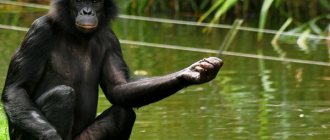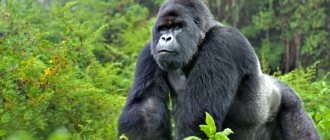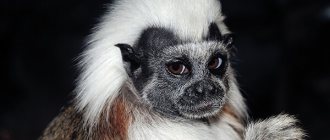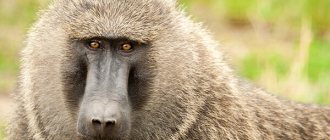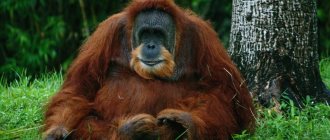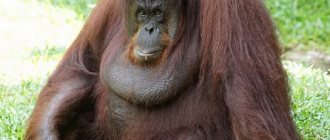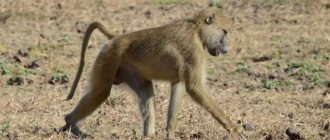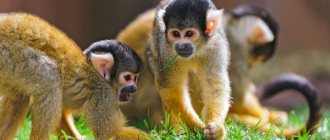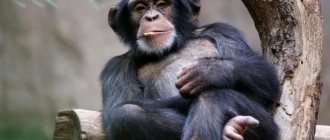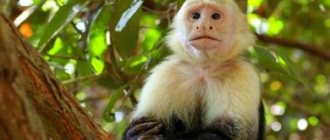Today it is becoming popular to keep exotic animals at home. Capuchin monkeys are often chosen as family pets, and this is not surprising, since these babies are interesting, playful and cute. These primates are not difficult to buy, you just have to go to the nearest zoo or nursery. But before deciding on such a purchase, it is important to know all the intricacies of keeping such animals. By taking care of this in advance, you will avoid unnecessary worries and create comfortable conditions for the capuchin.
Description of the monkey
This species of monkey belongs to the genus prehensile-tailed. They use their long tail, equal to the length of their body, to move along branches. Monkeys grow up to 60 cm in length. Moreover, their weight does not exceed five kilograms, usually less. Their fur is thick all over their body. Capuchin monkeys are divided into 4 species and several subspecies, so their color depends on the variety. But they all have a distinctive feature: there is a black spot on the head that resembles a cap or hood. The muzzle is light. For some, the “cap” is not so noticeable, but at the same time it descends from the top of the head to the nose and ends with a blade.
Life in nature and character traits
The capuchin monkey can still be found in the wild today. Primates spend time in trees, where they obtain food and also rest. They live exclusively in groups of 10–30 individuals, which makes it easier to obtain food and also reduces the risk of attack.
You will probably be interested in reading about how to care for monkeys at home.
Capuchins eat not only fruits and nuts, but also frog meat, bird eggs, and various insects, so it can be argued that the animals are omnivores. It is worth talking separately about the society of these primates.
They not only stay in groups, but also create their own hierarchy, where there is a main leader who, oddly enough, does not lay claim to the females, but only leads the “pack.” It is also the responsibility of each member to care for and protect the young, which, in case of danger, are rescued by all the adult monkeys.
Did you know? The Great Apes of the Old World are distinguished by the fact that they have 32 teeth, just like humans. New World primates, which include capuchins, have 4 fewer teeth.
Monkey character
These animals are very active and impulsive. They run fast. They move well on four legs on the ground and just as well jump along branches. Although they are wild animals, they quickly get used to people. Capuchins make a loud squeal, they communicate with sounds and at the same time their facial expressions are very developed. They express their emotions by their facial expressions.
The brain of these primates is well developed. They are quite smart and can learn complex things. Capuchin monkeys often copy some of the gestures and actions of their owners. Considering the active nature of these babies, it is worth remembering that their maintenance and care require a lot of time, patience, and also money. To prevent your baby from getting into trouble, you should not leave him unattended with complete freedom of movement. A leash is required for walks on the street, otherwise the monkey may run away.
Reproduction and offspring
Apellas are polygamous. It is the female who chooses the male. When the female is ready, she makes calling sounds and seduces the dominant male with poses. When the male notices a female ready to mate, he begins to sing in high notes. Primates mate once a day. After mating has taken place, the male will not allow other males to approach this female for another two days. During this time, the female will calm down and subsequently give birth to a baby from the strongest male.
The brown black-headed or crested capuchin can mate at any time of the year, but it has been noted that most offspring appear during drought and at the beginning of the rainy season. Therefore, we can say that the Capuchin wedding period falls on April-July. Females give birth once every two years.
Nutrition and maintenance
In order for the monkey to receive the necessary microelements, its diet must be varied. In nature, these animals eat fruits, bird eggs and chicks. They also catch insects and small lizards. Therefore, the home menu should include vegetables and fruits, such as apples, grapes, bananas, potatoes, oranges, peas, carrots. These foods can be either raw or cooked. They boil eggs hard-boiled. Sometimes you can pamper your baby with fish, chicken or beef. In pet stores you can find cookies and canned food for primates. Do not forget that you cannot overfeed them with sweets, because capuchin monkeys can suffer from diabetes. Bread and cereals are given to the animal in limited quantities. Since the animal is exotic, it is better to consult a specialist about a balanced menu.
Also, the monkey must have its own enclosure in order to leave it there when no one is looking after it. The length of such a “house” should be more than 1.5 meters. It needs to be equipped with ladders, ropes and safe toys.
Conditions for keeping a capuchin at home
You need to purchase a spacious enclosure, at least one and a half meters long with a large tray at the bottom. A metal one is best, inside which it is advisable to place ropes and various ladders.
This will provide the monkey with the ability to move and will resemble a natural habitat in the forest. Some animal lovers give their pets complete freedom of movement and do not restrict anything. But for safety reasons, it would still be better for the monkey to have his own house.
Before purchasing a capuchin monkey , think carefully and weigh your options. You need to find time for walks. The safest place for the duration of the trip is your reliable shoulder, but you should not give up the leash, which will limit the dangerous curiosity of the monkey on occasion.
Diversify your diet with high-quality food, buy vitamins. You can add boiled vegetables and hard-boiled eggs to your usual raw snacks, and wheat bread to your favorite free-ranging insects. Buy toys for your pet from the children's world that are also suitable for a child.
Distribution: North-Eastern Brazil, Eastern Andes (Colombia-Venezuela, Paraguay-northern Argentina. They live in tropical, subtropical, mountain forests of Argentina.
Upbringing
Once a monkey is brought into the house, problems may immediately arise as these animals may be afraid or show their temper. This moment cannot be missed, and you must immediately show that you are stronger, but at the same time remain a loving owner with whom you can find refuge. If not raised correctly, capuchins can become aggressive and even bite. It is important to immediately stop and punish this.
Owners are also interested in how long capuchin monkeys live. With proper care, these primates can live more than 25 years. Therefore, before purchasing such an animal, you need to think about whether you will get tired during this time, because the capuchin, like a small child, requires a lot of attention and proper care.
Choosing an animal: what to look for
The most common are brown capuchins, which can be purchased both from experienced breeders and in private zoos. It is worth understanding that the animal must meet certain standards, otherwise you will acquire a sick primate.
A healthy animal must have intact skin, and the coat must have a good aesthetic appearance. Bald spots or torn tufts are not allowed. It is also worth paying attention to the animal’s mobility and energy.
A healthy capuchin does not sit in one place, but tries to constantly move. The animal must want to eat, so if you offer it a treat, but the primate refuses it, then there are health problems.
Separately, it is worth mentioning age. You should buy capuchins that have reached 5 months of age, since it is from this moment that animals can eat regular food, and not mother’s milk. This is very important, since you simply cannot replace the mother's milk, which is why the baby will die.
Do not forget that an experienced breeder who loves his pets will be happy to tell you what a primate loves, how to care for it, how to communicate correctly and what not to do.
If a breeder is trying to sell a primate as quickly as possible, it means that he simply does not care about these creatures, which, as practice shows, negatively affects the health and emotional state of monkeys. Many people are interested in how much a pet capuchin monkey costs.
The cost of a healthy young primate starts at $2.5 thousand. It’s worth clarifying right away that the high purchase price indicates not only the quality, but also that further costs for care and feeding will be considerable, so you shouldn’t spend a large amount in the hope that that the capuchin will eat from your table.
Health
Another nuance that needs to be taken into account is medical care, because the brown capuchin monkey is a primate that is physiologically close to humans and can become a carrier of diseases. If a cold or other illness runs in the family, it will most likely affect the monkey. An ordinary veterinarian may not provide adequate treatment; you need to find a veterinarian who specializes in primates. Every year the baby must undergo a medical examination and have blood tests. You should also check your pet for tuberculosis annually. In addition, the capuchin must receive a sufficient amount of UV rays. To do this, it is better to purchase a tanning lamp.
What other names can this breed have?
In addition to the name “brown capuchins”, they can be called: apelas, black-headed capuchins, fauns. These are all names of the same animal species. Interestingly, the brain in these animals makes up approximately 1.9% of their total weight. The human brain occupies about 2%, and the chimpanzee brain occupies 0.9%. Therefore, we can conclude that capuchins are intelligent and capable of learning as well as solving complex problems.
Capuchins (monkeys): reviews from owners
Undoubtedly, keeping such a sweet creature brings great joy, but at the same time a lot of trouble. Reviews from people who have purchased a capuchin show that it requires a lot of patience. During the first few days, he can scream for everything to be according to his will, and if he gives up, the primate will be the main one in the house and all his life he will have to adapt to his whims. Therefore, experienced owners recommend not giving in to its whims and showing firmness and determination, and sometimes in raising an animal you cannot do without a “whip”.
Lifestyle
Diurnal animals spending most of their time in trees. However, they descend to the ground more often than many other monkeys of the New World. They move mainly on four limbs. Forms large groups of up to 40 animals, the ratio of the number of males to the number of females in the group averages 0.71. With rare exceptions, females spend their entire lives next to their relatives.
Capuchin eats
Interesting Facts
Fact No. 1. The most popular legend about the origin of the popular cappuccino coffee is the one that tells about the sweet tricks of the Capuchin monks.
The fact is that coffee was initially considered a devilish drink and was prohibited for clergy of all ranks. But based on the fact that milk can “clean”, they began to add it to the drink. Then some technological improvements were made, and the foam from the cream, which was whipped after heating, was poured into the coffee. This way the foam stays on the surface longer, and we got cappuccino in its almost modern form.
Fact No. 2. One of the first monasteries of Capuchin monks was erected on the island of Sicily in Palermo. At that time, everything was built with the money of parishioners and donations from townspeople. The monastery was built in 1525. Throughout its existence, it became a crypt for the worthy and eminent. At first these were monks and high clergy, then they began to give permission for the burial of eminent citizens, glorious artisans and everyone who glorified Sicily and Palermo.
All the remains have long been transferred to specially constructed catacombs, where the biomaterial is surprisingly well preserved. The last burial here was in 1920, since there is no longer room to place mummies, and mummified remains are preserved here.
But crowds of tourists come here. The Capuchin Catacombs are now the most popular place in Palermo. The cost of the excursion is only a couple of euros. You can purchase or take a commemorative photo of the Capuchin monk. These small incomes support monastic life.
But since the monastery is active, the monks’ thoughts are mainly occupied with how to protect corruptible bodies from the curiosity of the laity.
A similar but smaller burial of Capuchin monks and priests of the Order exists in Austria in the Imperial Crypt in Vienna.
Lifestyle of brown black-headed capuchins
Fauns live in subtropical and tropical forests, but can also inhabit dry forests, and in the northwestern part of Argentina they inhabit mountain forests, climbing to altitudes of 200-1100 meters.
Males reach sexual maturity at 8 years of age, they leave the family group and find a new one.
Compared to other monkeys of the same size, crested capuchins are more intelligent. They will introduce a diurnal lifestyle, living in trees, and descend to the ground only in search of water.
Brown capuchins move on 4 legs, can climb trunks well and jump well on branches. Their arms and legs are short. But they are capable of jumping 3-4 meters. They can walk for short distances on two legs. The tail can be used as an additional limb.
Capuchins share their space with other primates. They never conflict with howler monkeys, and form mixed groups with squirrel monkeys. Most likely, in this way they protect themselves from predators, since vigilance is higher in mixed groups. There is no competition between different species of primates, since they occupy different feeding niches. For example, brown capuchins feed on small trees up to 10 meters, and white-fronted capuchins choose trees about 50 meters high.
During the dry season, when there is a shortage of food, clashes may occur between these species.
The feeding process of brown capuchins is noisy, and it is at this time that the most aggression occurs. They feed on edible parts of plants, nuts and vertebrates. Individuals do not share prey among themselves.
The main enemies of fauns are birds of prey: eagles and hawks. Members of the group warn each other about the approach of predators with loud cries. Capuchins are also hunted by jaguars, large species of snakes and other predators.
Apellas use the same routes to search for food. They move within their own area and do not travel long distances. During transitions, the young go first, followed by males and females, and at the end are mothers with their offspring.
Capuchin fauns can walk up to 2 thousand meters per day.
Among the New World monkeys, Apellas have the most varied diet, but they prefer fruit. They have strong jaws. Therefore, they can cope even with large-sized fruits. Although brown capuchins do not have opposable fingers on their hands, they skillfully handle small animals and can find insects under bark, in curled leaves, and the like. Sometimes they hunt squirrels, bats, lizards and destroy bird nests. During the dry season, when food is scarce, fauns eat palm trees.
Capuchins living in mangroves feed on oysters, crustaceans and other marine life. With the help of their square molars, they easily crack nuts.
Monkeys feel free in the trees, feeding on fruits and small insects.
For example, stones for splitting shells. They feed most actively in the early morning, and during the day they doze.
What do capuchins eat?
Capuchins eat mainly fruits, which make up more than half of the diet of these primates. At the same time, the diet of capuchins includes insects and plant foods. Capuchins feed on flowers, plant shoots, young leaves and berries. And also roots, buds, bark, seeds and nuts.
Among insects, the primate prefers the larvae of caterpillars, beetles, and ants. The capuchin also feeds on small birds, frogs and lizards. Animals look for insects and reptiles on tree leaves and under the bark. Monkeys often visit bird nests and steal eggs or chicks.
Since capuchins are very smart monkeys, before eating a frog, they can first knock it on a tree to clear it of mucus. Curious monkeys taste everything new and willingly share with others. These clever primates tap a nut with a stone to get the tasty kernel out.
Dangerous Enemies
The natural enemies of most capuchin monkeys are people and fairly large birds of prey, including eagles and hawks. Primates can also be exterminated by predators from the cat family and snakes. Local residents traditionally hunt some species of primates, using their meat for food purposes. Animals are also caught by poachers, so buying a capuchin monkey is not difficult. Species such as the yellow-bellied capuchin and some other subspecies are included in the IUCN Red List of Threatened Species.
Behavior
Capuchins live in the crowns of giant tropical trees, where they look for food, consisting of various fruits, nuts, seeds, succulent shoots, diversifying it with insects, tree frogs and the contents of discovered bird nests. These monkeys live in groups of 10-30 individuals in a certain territory. Capuchins are very active monkeys; they run and walk on all limbs, rarely on two legs, and sometimes jump. Their voices are full of various sounds. Capuchins enjoy a well-deserved reputation as one of America's most intelligent primate species.
In nature, nuts are often broken with stones or fruits that are too hard are beaten on hard branches of trees, and caught tree frogs are wiped on the bark of trees, removing mucus from them; in captivity they respond well to training. They are well known for their habit of rubbing odorous substances on their fur. When climbing trees, the capuchin often uses the tenacious end of its tail, which clings well to branches, but it cannot hang on its tail. Contrary to popular belief, Old World monkeys and the vast majority of New World monkeys cannot and do not hang by their tails. The exceptions in this regard are howler monkeys, woolly monkeys and spider monkeys.
Capuchin at the zoo
Capuchins live in colonies or herds. All day long they feed, play, or groom each other. All members of the herd take care of the cubs and rush to the rescue in case of danger. The leader of the herd is a high-ranking male, but he does not claim all the females, who are free to choose any male in their herd. The larger the group, the more successfully it can resist natural enemies (eagles and other birds of prey).
Charter
The first charter of the holy brotherhood was approved under the arches of the monastery of St. Euphemia in Rome in 1536.
The charter of the order of Capuchin monks is quite strict. They subjected themselves to regular and severe corporal punishment, had the right to move only on foot, and were obliged to lead an active social lifestyle, constantly helping and preaching, instructing parishioners or random fellow travelers on the true path.
The text of the Charter itself has changed several times over many centuries. It underwent transformations, since the order was essentially alive and its servants actively participated in the social life of society.
Revolutions, wars, the development of scientific and technical thought - all of this together influenced changes in the main constitutional document of the order. The last changes to the Charter were made in 1990.
Capuchin women
At the beginning of the 16th century, Maria Lourenza Longo arrived in Naples from Spain, who was captivated by the piety, modesty and abandonment of the representatives of the Capuchin Order. And she founded the Capuchin women’s community, where the basis was service to the Lord, humility, repentance, social service, and hard work.
The women's branch was divided into five most significant areas, where the difference is in the form and activity of serving the worldly society:
- Clarissa the Capuchin.
- Tertsians.
- Tertian Virgins of the Holy Family.
- Capuchin sisters of Rubatto's mother.
- Missionaries of Saint Francis of Assisi.
The women's monastic congregation of the Capuchins still exists, providing social assistance to those suffering and in need of shelter in various parts of the world.
Issues of occurrence
The fact is that after the reform of the Franciscan Order in 1517, there was a division into Observants and Conventuals. The Capuchins (Order of Friars Minor) were officially recognized on June 3, 1528 by Pope Clement VII. The founder of the order is considered to be the wandering Franciscan monk Matteo da Bascio (otherwise he was called Matthew Bassi), who earned the trust and favor of the Pope with his rather strict rules and religious zeal. He preached hermitage and a miserable existence for monks.
The founding date of the Order of Capuchin monks as a religious (Catholic) community is considered to be 1529. Not everything went well right away.
The Capuchins, monks of the order, were limited in their educational activities for a long time. They were not allowed to leave Italian territory until 1574. Nevertheless, the community grew and built up its internal structure. First of all, an education system was created where future missionaries were trained.
By the end of the 18th century, the number of monks of the Capuchin Order reached 35 thousand people, they spread throughout Europe, Africa, the Americas, and Asia.
The modern order has 11,500 communities (monasteries, parishes, missions) and more than 75 thousand members
Since 2004, the Mission of the Order of Friars Minor Capuchin has been located in Russia.
A little about fashion and style
Capuchin literally means “sharp hood” in Latin. Indeed, the clothing of the Capuchin monks was set in the form of a brown cassock with a pointed hood.
It was allowed to gird oneself with a rope belt with a knot, which was a symbol of the strength of monastic vows.
And simple sandals were put on bare feet. Considering the fact that the roads in those days were not much different from impenetrable forest thickets, this is a real example of the pacification of the flesh.
Although, according to the testimony of private historians, not all monks and nuns of the order were so ascetic.
